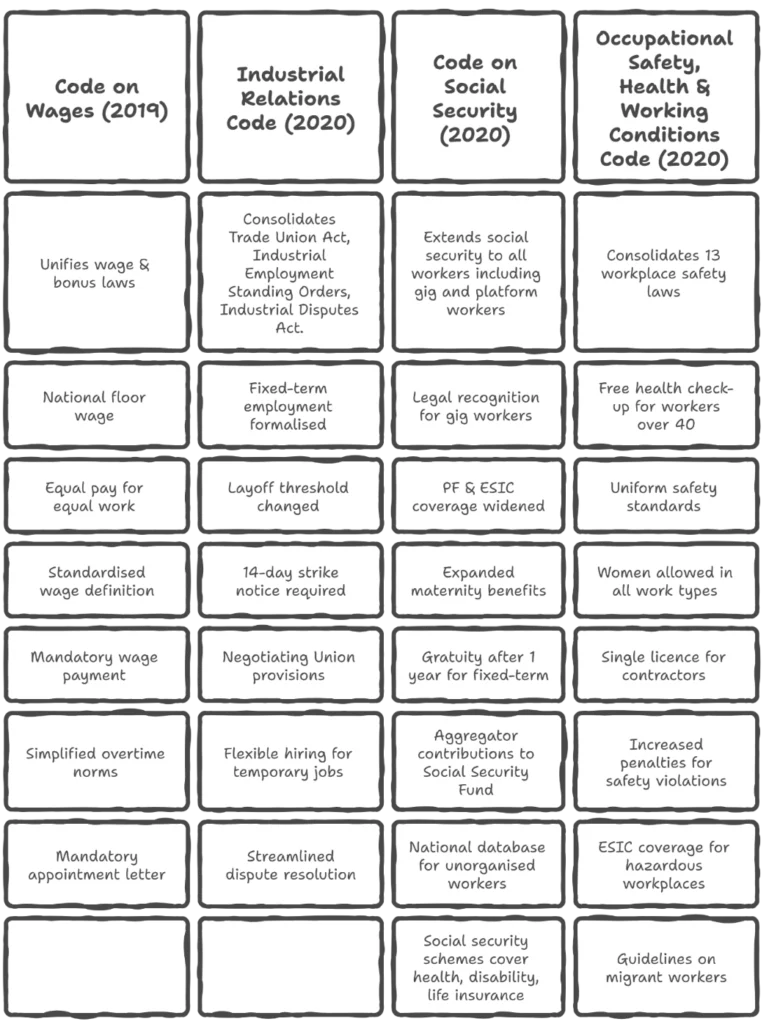Paper: GS – II, Subject: Polity, Topic: Governance, Issue: New Labour Codes.
Context:
The Central Government has notified all four Labour Codes—Wages, Industrial Relations, Social Security, and Occupational Safety—replacing 29 fragmented labour laws. This marks India’s biggest labour reform since Independence, expanding social security and formalising labour markets.
Key Takeaways:
- Labour reforms cleared by Parliament in 2019–2020, but implementation stalled due to:
- Delay in framing rules
- Resistance from trade unions
- State-level readiness issues
- Codes aim to simplify compliance and widen social protection in line with India’s manufacturing ambitions.
The Labour Codes aim to simplify India’s complex labour law structure and address challenges of informalisation, gig work, and workplace safety. They consolidate 29 pre-Independence and early post-Independence laws into four modern Codes:
- Code on Wages (2019)
- Industrial Relations Code (2020)
- Code on Social Security (2020)
- Occupational Safety, Health and Working Conditions Code (2020)
They seek to expand the social security net, ensure minimum wages for all, improve working conditions, and support ease of doing business.
KEY COMPONENTS OF THE FOUR LABOUR CODES:

| Key Terms: National Floor Wage: A minimum wage fixed by the Central Government below which no state can pay.Gig Worker: A gig worker is anyone who works on short-term, task-based, or freelance work, whether or not a digital platform is involved.Platform Worker: A platform worker is a gig worker who gets work specifically through a digital platform/app. Example: Ola DriverGratuity: A lump-sum payment by employer as a reward for long service. |
Significance:
- Simplifies 29 outdated laws into 4 modern codes.
- Expands social protection in a largely informal workforce (≈90%).
- Boosts investment climate through reduced compliance burden.
- Encourages more women to join workforce.
Issues:
- Trade unions call Codes “anti-worker” & “pro-employer”.
- Implementation hinges on states → possible non-uniform rollout.
- Gig workers’ welfare fund & contribution-sharing still unclear.
- Risk of easier layoffs under IR Code.
Data:
- Informal workforce: ~90% of India’s total labour force.
- Gig workers: 77 lakhs (2023) → projected 2.35 crore by 2030 (NITI Aayog).
- 29 old laws from 1930s–1950s replaced.
- ESIC beneficiaries ~3.6 crore (pre-expansion).
Real-life Example:
A Swiggy delivery partner will now get statutory social security benefits for the first time under the Social Security Code—gratuity, accident coverage, and PF-like contributions (based on future rules).
https://indianexpress.com/article/business/labour-codes-rules-expected-week-govt-10378405
La Excellence IAS Academy, the best IAS coaching in Hyderabad, known for delivering quality content and conceptual clarity for UPSC 2025 preparation.
FOLLOW US ON:
◉ YouTube : https://www.youtube.com/@CivilsPrepTeam
◉ Facebook: https://www.facebook.com/LaExcellenceIAS
◉ Instagram: https://www.instagram.com/laexcellenceiasacademy/
GET IN TOUCH:
Contact us at info@laex.in, https://laex.in/contact-us/
or Call us @ +91 9052 29 2929, +91 9052 99 2929, +91 9154 24 2140
OUR BRANCHES:
Head Office: H No: 1-10-225A, Beside AEVA Fertility Center, Ashok Nagar Extension, VV Giri Nagar, Ashok Nagar, Hyderabad, 500020
Madhapur: Flat no: 301, survey no 58-60, Guttala begumpet Madhapur metro pillar: 1524, Rangareddy Hyderabad, Telangana 500081
Bangalore: Plot No: 99, 2nd floor, 80 Feet Road, Beside Poorvika Mobiles, Chandra Layout, Attiguppe, Near Vijaya Nagara, Bengaluru, 560040

